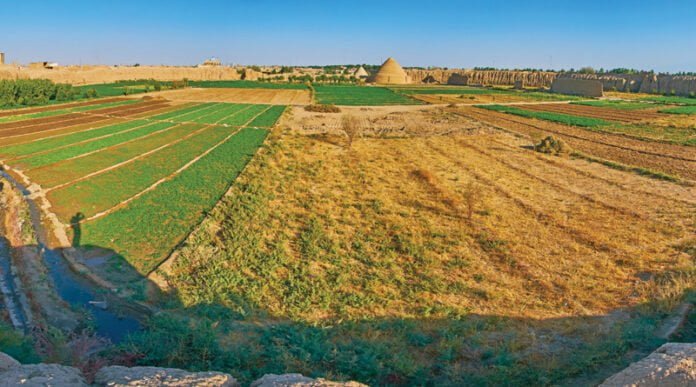Past returns are not guarantees of future results, but during a panel at Greenbuild International Conference and Expo, experts used the past as evidence for strategies that can help us address climate change and create more sustainable landscaping.
Julia Watson, an author and design consultant who teaches urban design at Harvard and Columbia, urges designers and architects to look to the past for sustainable technology.
Watson is Australian, and noted that, like the U.S., her country suffered devastating wildfires this year caused by seasonal drought, delayed rains from global warming, as well as “century-old bans on traditional ecological technologies.”
“In the midst of all this catastrophe, we’ve learned something that was really interesting,” Watson said. “The ancestral lands that still practice pyro-technology, or what we call cultural burning, they were saved as these wildfires raged around them.”
Pyro-technology involves “slow, cool burning that’s guided by something called ecological knowledge. That knowledge has been passed down for generations,” Watson explained.
Watson asked, “if sustainability is the answer, then what was the question? … Will sustainability really save us if we don’t systemically change the conditions by which we understand progress?”
RELATED: Understanding Green Roofs and Water Sustainability
She is a proponent of using strategies informed by ecological knowledge to address sustainability in the built environment.
“Frankly, if we’re really serious about mitigating climate change, we need to consider that the most effective way to do this is not by replicating a small number of costly solutions that have been developed in wealthy nations,” she said. Solutions that are “embedded in the traditional ecological knowledge of a people and a community in their environment [are] the most effective way to approach resilience at scale.”
She shared examples of some of those technologies that are used in other parts of the world:
- Yakhchal. These evaporative coolers store ice that forms in underground aqueducts. Underground tunnels and channels are hand-dug, Watson explained, to direct water from mountain sources to cities within an aquifer’s watershed. Yakhchals originated in Persia and are around 3,000 years old, she said.
- Al tahla. Some villages in Southern Iraq use qasab reeds to build floating islands and villages, Watson said. They can be built in three days, and may last 25 years with continued maintenance. She said this type of construction is depicted in Sumerian imagery, and is estimated to be around 6,500 years old.
- Wastewater aquaculture. Watson described a wastewater treatment system outside of Kolkata in India that uses sunlight and “a symbiosis between algae and bacteria” to clean the water. Water is filtered through 300 fish ponds “that continue cleaning the water in a process that takes 30 days.”
These technologies are examples of how climate mitigation solutions don’t need to be passive, Watson said. “They can be active, they can be productive, they can be adaptive, and they can be incredibly complex coexistences of many human and nonhuman species that actually use biodiversity as a building block for the future.”
Out of the fire, into the flood
Kotchakorn Voraakhom is CEO and founder of Bangkok-based landscape firm Landprocess and Porous City Network, which uses sustainable landscaping in public green spaces like urban farms, green roofs, rain gardens, and permeable parking to control excess water in the city.
Flooding is becoming a “new normal” in cities around the world, Voraakhom said. “As a landscape architect, we cannot just rely … on the sewer system” to prevent flooding.
Voraakhom gave some examples of ways that landscape architecture and design can help control water in areas prone to flooding.
Urban farming. Thammasat University boasts the largest urban farm and green roof in Asia, Voraakhom said. Inspired by mountainside rice terraces, her firm used tiered gardens, retention ponds and rooftop crops to slow down run off during heavy rains and store water for other uses. Food grown on the roof supplies the campus, and at over 236,000 square feet, the rooftop helps reduce the heat island effect significantly.
Walkable cities. Voraakhom noted that Bangkok is one of the most congested cities in the world. Landprocess used an abandoned railway to build a pedestrian bridge that creates usable green space between two freeways crossing the Chao Phraya River.
Although Colorado isn’t facing that level of congestion, a 2018 report by the Denver Regional Council of Governments found that vehicle miles traveled in the metro area are expected to increase 43% by 2040, with a 132% increase in traffic delays. The economic cost of those delays is almost $3 billion annually.
‘Hedonistic sustainability’
Catherine Huang, partner at BIG-Bjarke Ingels Group in Copenhagen, said that sustainability “shouldn’t be about giving things up. That’s not a sustainable mindset. We have a term ‘hedonistic stainability.’ It’s about being better for the environment in a way that’s more enjoyable.”
She reiterated Watson’s point that ancient technologies are a useful starting point for thinking about sustainability.
“I’m not proposing the return to the natural style, but that we make use of technology to stand on the shoulders of giants, use simulations and algorithms to shift performance away from the mechanical room and back into the permanent attributes of the design,” Huang said.
For example, Mediterranean villages use thermal mass and white paint to control heat, and igloos are designed to minimize surface area and optimize insulating properties, she said.
‘Finding the edges’
Design is about “finding the edges,” Huang said, and without the constraints put in place by sustainability needs or code requirements, “I almost feel like you don’t actually have design. … Without those kinds of boundaries, then there’s no way to judge if design is successful or not.”
Those constraints inspire creativity as designers look for new strategies to address climate change with sustainable landscaping. Some of those strategies may not be wholly new, as Watson noted.
“As we’re seemingly drowning in the age of information, while we are starving for this stuff, we find ourselves at a crossroads,” she said. “We can either continue this narrow view of technology that’s informed by our distance from nature, or we can acknowledge that the current dominant model of progress is just one way, and it is not the only way for humans to live and to design in response to climate change.”







